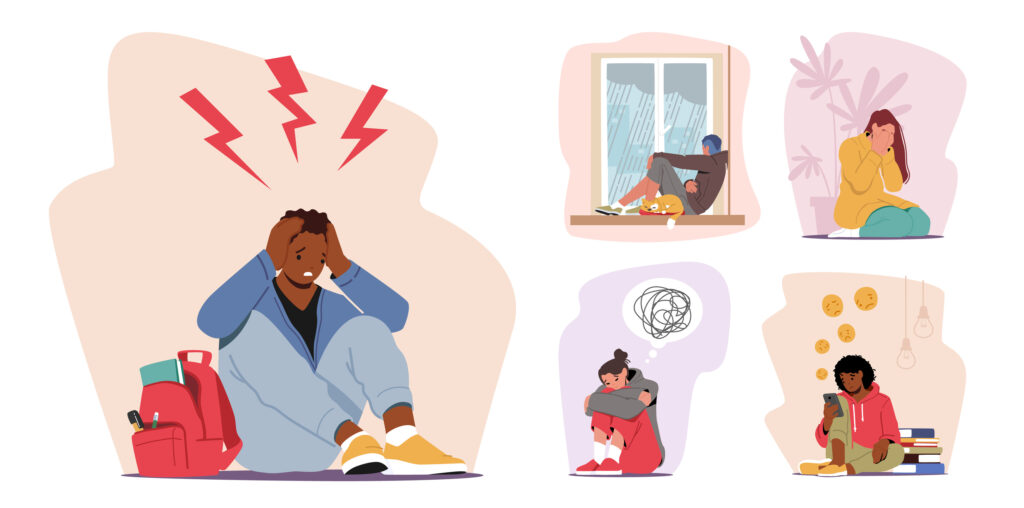It’s no secret that the pandemic has had profound effects on the mental and emotional well-being of our society. Rates of mental health struggles have skyrocketed in response to experiences of isolation, grief and loss, economic hardship, safety fears, and increasing uncertainty about how the future will unfold.
Prior to the pandemic, it was clear we were facing a youth mental health crisis, but the experiences of a pandemic have proved to amplify this already concerning situation. For teenagers, experiencing a pandemic has caused an uptick in mental health concerns during a developmental period that in the best of times is already fraught with stress, self-esteem concerns, and constant change.
These youth have missed out on normative and expected experiences of high school like after-school clubs, dances, sporting events, and graduations. They’ve received substantially less in-person support from teachers and support staff, clubs and support groups for marginalized identities, and for some kids, tangible support like food assistance and access to supplies. Without regular contact from professionals trained to notice early signs and symptoms of mental health concerns, many children went without care for significantly longer than they would otherwise, leading to more severe symptoms and potential safety concerns.
The effects of the pandemic disproportionately affected communities of color, amplifying stress for those teenagers. Experiences of racism and discrimination, both those related to and co-occurring with the pandemic, have continued to erode youth mental health.
Ask any teenager or teacher, parent, or mental health therapist who regularly interacts with teens, and they’ll have anecdotal evidence of these increases. Now, nearly 3 years after the pandemic began, we are finally able to collect and analyze data on how teenagers have been affected. Here are a few key points:
37% of high school-aged students reported they experienced poor mental health during the pandemic1.
44% reported feeling persistently sad or hopeless during this time1.
Emergency room visits for suicide attempts were 51% higher for female identifying-youth, and 4% higher for male-identifying youth when compared to the same time period prior to the pandemic in 2019 2.
What can we do?
Seeing these statistics can be frightening, especially when they are the result of something beyond our control and related to responses that were critical to maintaining physical safety within our communities, but it does also give us insight into how to begin improving this crisis.
- School
The data, combined with years of anecdotal experience from school staff, has spurred many school districts into action to increase support programs and access to mental and emotional well-being resources. In the same study, school connectedness, defined as “a sense of being cared for, supported, and belonging at school” was a clear protective factor. High school students who felt connected to support at school were 20% less likely to report persistent sadness and hopelessness, 12% less likely to consider suicide, and 6% less likely to attempt. Working to create a safe supportive school environment is a crucial step for all communities.
- Home
Treat your teens with care. The pandemic has affected us all, but teens have experienced a version of difficulty that is nearly impossible for adults to fully comprehend. Make space regularly to talk about how they’ve been affected, and acknowledge how challenging this has been for them without diminishing it in relation to others’ struggles. Support their efforts to maintain relationships and be a safe place to process uncertainty, fear, and sadness.
- Professional Supports
If they aren’t already, now is the time to get your teen connected to a therapist. While the role of a supportive family is paramount, having a specific, private space to process their emotions and fears is vital in helping improve their mental health. A trained professional can offer tailored coping skills, referrals to other providers as needed, and above all, the feeling that their emotional struggle has been seen and heard. Even if your teen has not been showing obvious signs of a mental health struggle, ask them. Many teens cope by keeping things bottled up, and they may not know how to ask for help. Offer to connect them to a therapist regularly, and if or when they say yes, follow through until they find a match.

Listen Like a Counselor – How to Help Your Depressed Teen
Teen depression can bring an array of emotions and behaviors that parents struggle to understand. An urge to isolate, to experience intense feelings alone Difficulty maintaining motivation with chores or homework Disinterest in usual hobbies or interests An opposite...
5 Steps to Coping with Panic Attacks
Unless you are face-to-face with a bear or another physical danger, nothing feels more terrifying than a panic attack. Many have gone to the Emergency Room fearing heart attacks, strokes, and death. With symptoms including chest tightening, throat constricting, and...
Depression & Obsession: Social Media Disclaimers
At no other time in history have we been able to connect so well with long-distance loved-ones, receive instant feedback on an idea, belly laugh at goofy memes, or find welcome distraction in someone else’s story. In many ways, social media has been a tremendous gift...
Active vs. Passive Anxiety
Have you ever felt like someone is playing tug-of-war with you, except you are the rope? Being pulled in too many directions can be exhausting, and if it happens over an extended length of time, it can lead to extreme anxiety or burnout. If...
Powerful Thoughts on Self-Worth
Those that have struggled with depression have experienced first-hand the fight for "enoughness." Below you will find words of inspiration meant to challenge your view of self: "If my aim is to prove I am 'enough,' the project goes on to infinity- because the battle...

